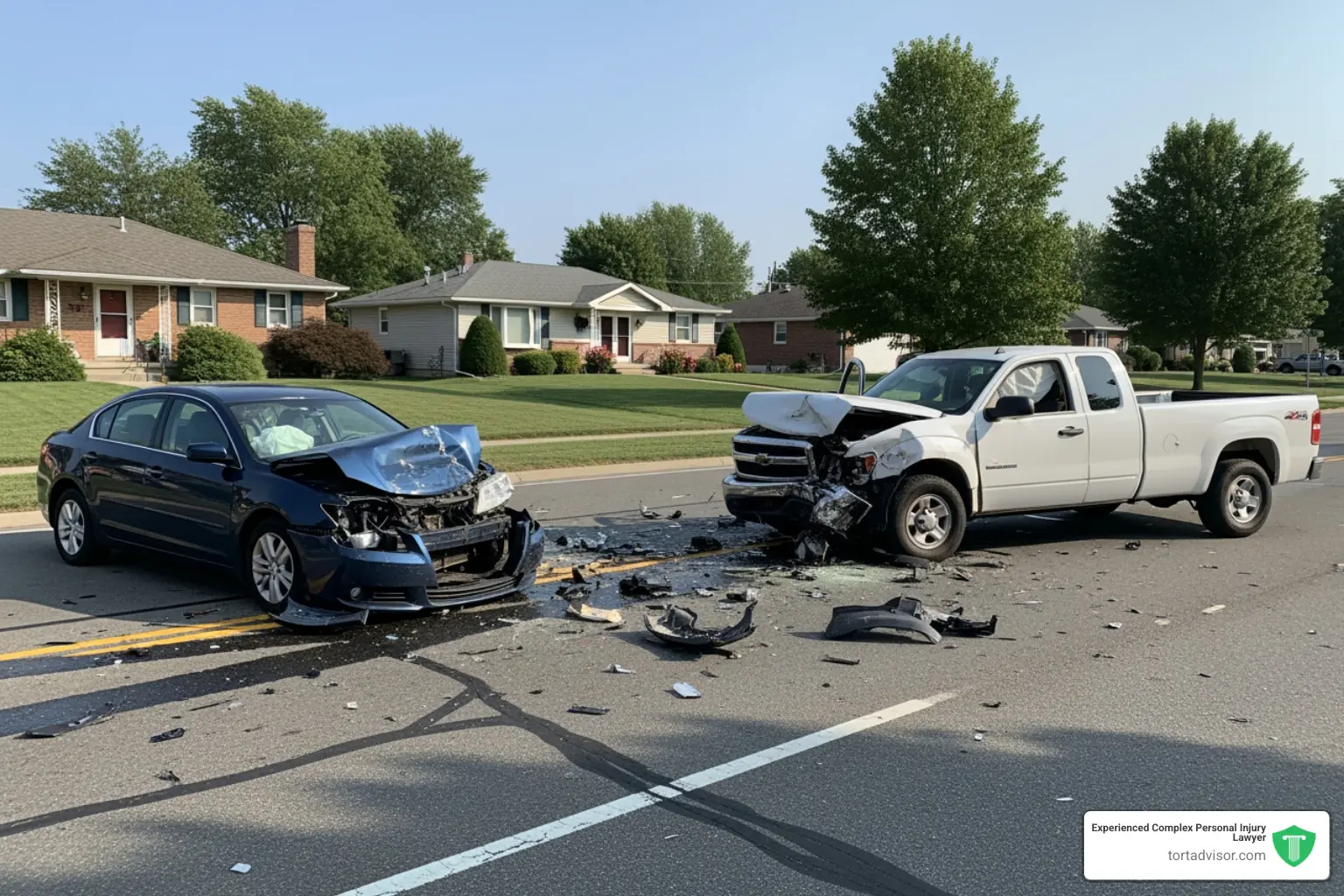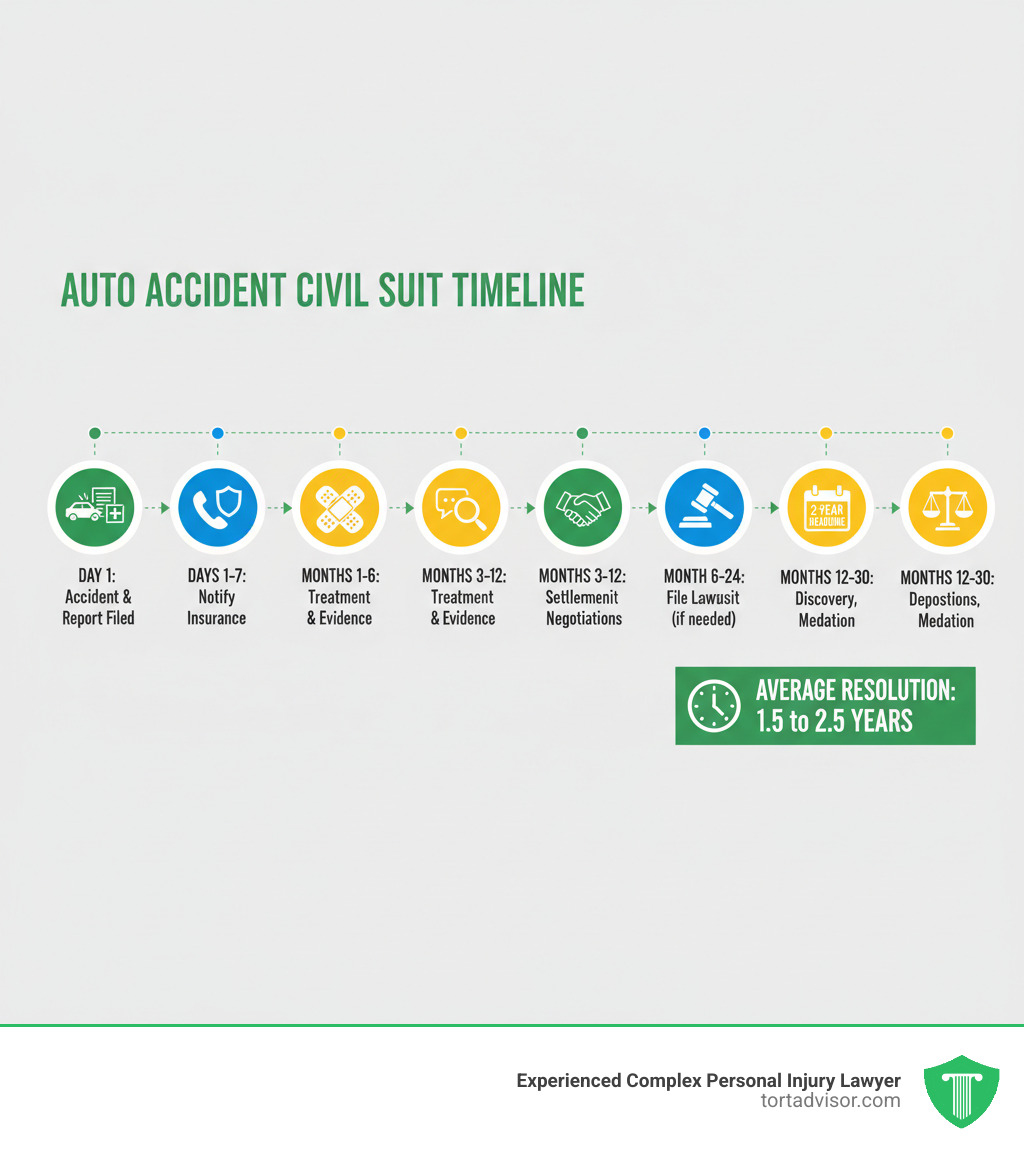


What You Need to Know About Auto Accident Civil Suits
An auto accident civil suit is a legal action where an injured party sues a responsible party to recover damages beyond what insurance covers. Here’s a brief overview:
Key Facts About Auto Accident Civil Suits:
- Purpose: To recover compensation for injuries, lost wages, pain and suffering, and property damage when insurance is inadequate.
- Who Can Be Sued: The at-fault driver, vehicle owner, employer, manufacturer, or government entities.
- Timeline: You typically have 2 years from the accident date to file (varies by state).
- Settlement Rate: Approximately 95% of cases settle before reaching trial.
- Costs: Most personal injury lawyers work on contingency (no upfront fees, they take 33-40% of the settlement).
- When Needed: When injuries are severe, fault is disputed, or insurance refuses fair compensation.
The basic process flows like this:
- Accident occurs and evidence is gathered.
- An insurance claim is filed.
- If settlement fails, a lawsuit is filed in court.
- Discovery phase (gathering evidence, depositions).
- Mediation or settlement negotiations.
- Trial (if no settlement is reached).
An insurance claim is an informal negotiation with an adjuster. A civil suit is formal litigation in court with strict rules and procedures. A lawsuit becomes necessary when an insurer denies your claim, offers too little, or when your damages exceed policy limits. You should consider a civil suit if you’ve suffered serious injuries, your medical bills exceed insurance coverage, or the other driver was uninsured or underinsured.

The Immediate Aftermath: Critical First Steps and Insurance Claims
What you do in the first minutes after a car accident can significantly impact any future auto accident civil suit and your ability to recover fair compensation.

Safety comes first. Check for injuries and call 911 if anyone is hurt. If safe, move your vehicle out of traffic. Most states legally require you to stop, render aid, and notify police. Leaving the scene can lead to criminal charges.
Once safe, exchange information with the other driver, including their name, phone number, and insurance details. Get contact information from any witnesses. Report the accident to the police, as the official report is a key piece of evidence. In Texas, for example, you can get a copy via the Texas Department of Transportation’s Crash Report Online Purchase system.
Notify your insurance company as soon as possible, ideally within 24 hours. This starts the claims process. Failing to report promptly could jeopardize your coverage. Our guide on How to Report a Motor Vehicle Accident offers a detailed walkthrough.
How claims work depends on whether you are in a no-fault or at-fault state. In at-fault states, the responsible driver’s insurance pays. In no-fault states, your own insurance covers initial medical costs, but you can still file an auto accident civil suit for severe injuries that meet your state’s threshold.
Understanding Your Insurance Coverage
Understanding your policy is essential. If the other driver was at fault, their liability coverage should cover your damages. Your own collision coverage pays for damage to your car regardless of fault. Driving uninsured is a serious problem. Most states, like Texas, require minimum liability insurance, as detailed by the Texas Department of Insurance. If you cause an accident without it, you face fines, license suspension, and personal liability for all damages.
If you switch insurance companies after an accident, the company that covered you at the time of the incident is responsible for handling that claim. Our Car Accident Lawyer Compensation Guide explains how attorneys can maximize your recovery when insurance companies try to minimize payouts.
Building Your Case: Liability, Evidence, and When to Sue
Determining liability—legal responsibility for the accident—is the foundation of any auto accident civil suit. In car accident cases, this means proving the other driver’s negligence directly caused your injuries and losses.

The police report is a critical first piece of evidence, but you’ll need more. Gather photographs and videos of vehicle damage and the scene, witness statements, medical records to document your injuries, and lost wage documentation from your employer. Our guide on What evidence do I need to prove my case? explains these in more detail.
You may still recover compensation if you were partially at fault. Most states use “comparative negligence,” which reduces your award by your percentage of fault. A few harsher “contributory negligence” states bar any recovery if you are even 1% at fault.
Who Can Be Sued and What Are the Legal Thresholds?
Identifying all responsible parties is crucial. This includes the at-fault driver, the vehicle owner, the driver’s employer (if they were working), and potentially a vehicle manufacturer or government entity. Be aware that suing government agencies involves very strict and short deadlines.
Some jurisdictions also have “injury thresholds,” requiring injuries to be “serious” or “permanent” before you can sue for pain and suffering. For example, some states or provinces require a “permanent serious impairment of an important physical, mental or psychological function” to file a suit. Others have government-run compensation systems, like Quebec’s SAAQ, that may bar civil suits for bodily injury altogether. These rules vary dramatically by location, so understanding your state’s specific laws is critical.
Our guide on Common Motor Vehicle Accident Injuries explains the types of injuries that often meet legal thresholds for a lawsuit.
Navigating the Auto Accident Civil Suit Process
When insurance negotiations fail, filing an auto accident civil suit may be your only path to fair compensation. Understanding the process can make it far less intimidating.

The statute of limitations is the legal deadline to file a lawsuit. Missing it will bar your claim, regardless of its merit. Most states, including California and Texas, have a two-year statute of limitations for an auto accident civil suit. Exceptions exist. The “discovery rule” may start the clock when an injury is discovered, not when it occurred. For minors, the clock often doesn’t start until they turn 18. Deadlines for suing government entities are often much shorter. Don’t wait to act; our guide on How long do I have to file a lawsuit? provides more detail.
Finding the right attorney is your most important decision. Look for a specialist in auto accident cases with a strong track record. Most personal injury lawyers work on contingency fees, meaning you pay nothing upfront. They receive a percentage (typically 33-40%) of the settlement only if you win. This allows you to access top legal help without financial risk. Our Personal Injury Lawyer Ultimate Guide and guide on how much a personal injury lawyer costs offer more information.
Key Steps in an Auto Accident Civil Suit
The lawsuit begins by filing a complaint (or statement of claim), a document outlining your case. In California, this involves forms like the Summons (form SUM-100). After the defendant is served and responds, the discovery phase begins. This is a formal process of exchanging evidence through written questions (interrogatories), document requests, and depositions (sworn, out-of-court testimony).
The defense may also request an independent medical examination to assess your injuries. Throughout this process, settlement negotiations are ongoing, often leading to mediation with a neutral third party. While the entire process can take 1.5 to 2.5 years, about 95% of auto accident civil suits settle before trial.
Compensation and Resolution: Settlements, Trials, and Payouts
An auto accident civil suit is about getting you fairly compensated for your losses. This is achieved through a negotiated settlement or a trial verdict.

Approximately 95% of personal injury cases settle before trial. Filing an auto accident civil suit is often powerful leverage that forces insurance companies to negotiate seriously. Be wary of early, low-ball settlement offers from insurance adjusters, whose goal is to minimize payouts. Never sign a settlement agreement without an attorney’s review, as you may waive your right to future compensation.
When direct negotiations stall, mediation with a neutral third party can help break the deadlock. If mediation fails, the case moves toward trial, where a judge or jury will decide the outcome. While appealing a court decision is possible for legal errors, settlements are binding agreements. The entire process, from accident to resolution, typically takes 1.5 to 2.5 years. Our MVA Settlement Calculator can offer a preliminary estimate, but every case is unique.
Understanding Damages in an Auto Accident Civil Suit
“Damages” are the monetary award designed to compensate you for your losses. They fall into two categories.
Economic damages are tangible financial losses you can document. This includes past and future medical expenses, lost wages, loss of future earning capacity, and property damage.
Non-economic damages, often called “pain and suffering,” compensate for physical pain, emotional distress, and loss of enjoyment of life. Claiming these damages is complex, as the value depends on injury severity and its impact on your life. Some jurisdictions impose caps on non-economic damages or require injuries to meet a high threshold, such as a “permanent serious impairment.” Others may apply a statutory deductible to pain and suffering awards. These limitations vary widely, making legal guidance essential. Our guide on what kind of compensation victims could receive provides more context.

Frequently Asked Questions about Auto Accident Civil Suits
Here are answers to some of the most common concerns about auto accident civil suits.
How long do I have to file a car accident lawsuit?
The “statute of limitations” is the legal deadline for filing your lawsuit. If you miss it, you lose your right to sue. The general rule in most states, including California and Texas, is two years from the date of the accident.
There are important exceptions. The “discovery rule” applies when an injury isn’t immediately obvious; the clock may start when the injury is discovered, not on the accident date. For minors, the statute of limitations often doesn’t start until they turn 18. Critically, lawsuits against government entities have much shorter deadlines, sometimes only a few months to file a notice of claim. Don’t wait—consult an attorney as soon as possible. For more details, see our resource on How long do I have to file a lawsuit?.
Do I need my own attorney if my insurance company provides one?
When you are sued, your insurance company will provide a lawyer to defend you. However, that lawyer’s primary loyalty is to the insurer. A conflict of interest can arise if the damages claimed against you exceed your policy limits. The insurer’s lawyer may focus on settling within the policy limit, leaving you personally liable for any excess amount.
In situations where your personal assets are at risk, hiring your own independent attorney is wise. This lawyer works only for you, ensuring your personal interests are protected. Our guide Do I need a personal injury lawyer? can help you think through this decision.
What happens if I am sued personally after a car accident?
Immediately notify your insurance company if you are sued. Your policy requires prompt notification, and your insurer is obligated to assign an attorney to defend you. Do not ignore the lawsuit. You must respond within a set time (usually 20-30 days) to avoid a “default judgment,” which is an automatic loss.
If you are found liable, your insurance pays up to your policy limits. You are personally responsible for any amount above your coverage. Being uninsured is a financial nightmare, as you are liable for all damages from the start. While some assets may be protected from collection, as noted in resources like Automobile Accidents: Personal Injury Lawsuits, you should consult an attorney to understand your risk.
Conclusion
Navigating an auto accident civil suit is a complex journey, from the crash scene to the final resolution. It involves strict deadlines like the statute of limitations, gathering evidence, and negotiating with insurance companies. While most cases (about 95%) settle out of court, the threat of a lawsuit provides crucial leverage for securing fair compensation for your damages.
Attempting to handle this process alone is risky. Procedural errors, missed deadlines, or a premature settlement can jeopardize your case and leave significant compensation on the table. This is why expert legal guidance is essential.
A skilled personal injury attorney understands the laws in your state, knows how to counter insurance company tactics, and can maximize your recovery. At Tort Advisor, we connect injured people with highly skilled, specialist attorneys who work on contingency—you pay nothing unless they win. You have nothing to lose by getting a professional evaluation of your case.
Your focus should be on healing. Let an experienced attorney handle the legal battle.
Find the right legal expert for your Car Accident Lawsuit
Free Confidential Case Evaluation
Complete the short form below to get an immediate FREE case review with an expert in your specific claim. Don't wait, your case could be time sensitive to file a claim.
Related Posts
Prove your SSDI for anxiety case. Learn SSA criteria, gather crucial evidence, and navigate the application process with our expert guide.
Beyond retirement, explore all your Social Security benefits. Understand types, apply, and manage claims for security.
Conquer your SSDI claim! Master the process with expert SSDI application tips, documentation, and appeal strategies. Apply smart.
North Miami Beach car accident lawyer needed? Get expert help navigating Florida laws & maximizing your claim. Don't get wrecked twice!
After an Alberta car accident? Our guide covers critical steps, compensation, and how car accident lawyers help you recover what you deserve.
Stop Disability benefits fraud! Learn what it is, how to report it, and its severe consequences. Protect vital benefits.


